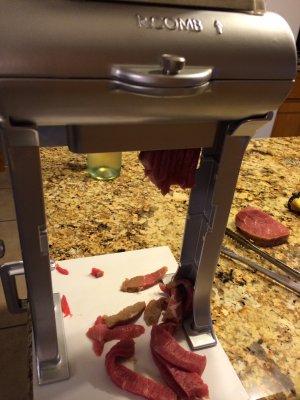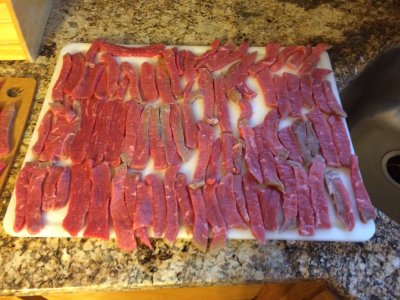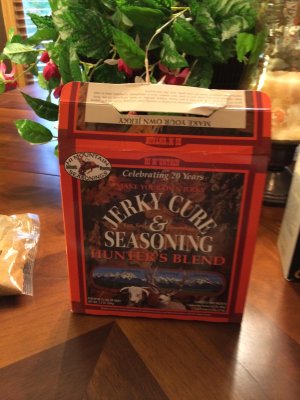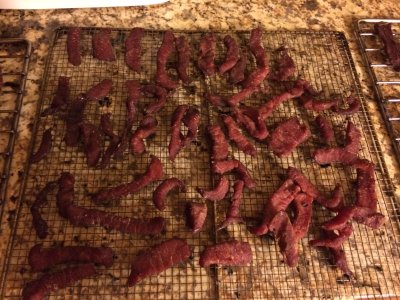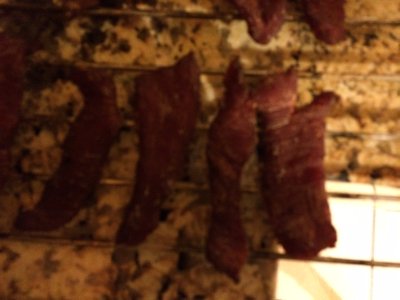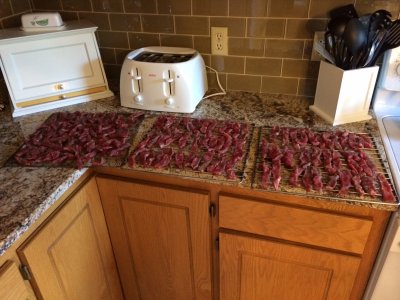You are using an out of date browser. It may not display this or other websites correctly.
You should upgrade or use an alternative browser.
You should upgrade or use an alternative browser.
First try at jerky
- Thread starter MNGuy1959
- Start date
MNGuy1959
Member
I installed my permanent probe for my Auber PID, auto tuned, and set the temp to 140 degrees. I used 2.5 ounces of hickory and apple chips. After two hours at 140, I had just a small whiff of smoke coming from my smoker, and I put the James Jerky Dryer on top of the smoker and started it up. I let it run for an additional 4 hours.
Here are the results.
Here are the results.
Attachments
MNGuy1959
Member
I had three racks total, and I am happy with the results. I brought some into work today, and my coworkers thought it was some of the best jerky they have ever had! I learned a few things. I will always slice my jerky 'with' the grain, as those pieces were more tender than the ones against the grain. I probably would remove after 3.5 hours, but the jerky is still nice and chewy. The taste and amount of smoke were perfect, but some pieces did seem a bit too dry (just the smaller pieces). I had three nice racks of jerky, and I absolutely love the dryer. The permanent probe was spot on and only varied my temp by 1 degree. I had three complete racks of jerky, and it is already half gone  .
.
 .
. Attachments
MNGuy1959
Member
The above pick was after seasoning in a vacuum sealed bag for about 30 hours, but before the smoke process. Still, it was just a real fun experience, and I am going to make a new batch next weekend, so I have some available when I start hunting later this fall, and for ice fishing this winter.
MNGuy1959
Member
Hi Gregg:
Thanks. Yes, I found that I can only have the meat about an inch to 1.5 inches thick. I agree with you. I would just use the slicer you have. I do like this jerky slicer, but mainly, I was looking for a consistent cut and thickness to the jerky. It was a blast making this, and the smell was as great as the taste .
.
Thanks. Yes, I found that I can only have the meat about an inch to 1.5 inches thick. I agree with you. I would just use the slicer you have. I do like this jerky slicer, but mainly, I was looking for a consistent cut and thickness to the jerky. It was a blast making this, and the smell was as great as the taste
 .
. DivotMaker
New member
Nice job, Gene! How long did you let the meat sit in the fridge with the Hi Country seasoning on? Pretty sure it has Instacure #2 in it, to dry cure the jerky. I haven't used their seasoning, so I'm just wondering.
NDKoze
Moderator
I made some jerky this past weekend with the High Country Teriyaki seasoning. I have used Various High Country seasonings as well as High Mountain seasoning. I have had very good luck with both brands making whole muscle as well as ground/extruded jerky.
The High Country even has several Non-MSG blends (for Tony and others who can't have the MSG).
Both brands come with cure packets that "can" be omitted. It doesn't specifically say whether it is #1 or #2 in the instructions. But I assumed it was #1 since it is pink. The instructions say the following:
I always let mine rest overnight. The seasonings really soak through and permeate the meat with a good overnight rest.
The High Country even has several Non-MSG blends (for Tony and others who can't have the MSG).
Both brands come with cure packets that "can" be omitted. It doesn't specifically say whether it is #1 or #2 in the instructions. But I assumed it was #1 since it is pink. The instructions say the following:
The separate cure packet allows the option to omit the cure without compromising the quality of the finished product. The cure packets contain sodium nitrite and salt. When mixed with meat it prevents most forms of spoilage for a limited amount of time. Sodium Nitrite is a color affixer used to obtain a uniform reddish-pink color in the meat.
I always let mine rest overnight. The seasonings really soak through and permeate the meat with a good overnight rest.
Pork Belly
Moderator
Sodium nitrite does help to set the color but that is not the big reason for using it. Sodium nitrite prevents botulism from setting in and growing during the low temp smoke. Do not be fooled all processed meats have nitrates added. Please don't skip this step.
When you see products like bacon, jerky or lunch meat that say no nitrates added they can say that because the didn't add sodium nitrate BUT they did add spinach and other green leafy vegetables that are very high in naturally occurring nitrates.
Up until a few years ago I never used curing salt (Nitrates) when making jerky. Now that I have immersed myself in salting smoking and curing I wont skip it. Congratulations on your first batch being successful.
When you see products like bacon, jerky or lunch meat that say no nitrates added they can say that because the didn't add sodium nitrate BUT they did add spinach and other green leafy vegetables that are very high in naturally occurring nitrates.
Up until a few years ago I never used curing salt (Nitrates) when making jerky. Now that I have immersed myself in salting smoking and curing I wont skip it. Congratulations on your first batch being successful.
MNGuy1959
Member
Thanks, Tony, Gregg and Brian:
Tony, I seasoned the jerky with the cure mixture and then I vacuum sealed the jerky and put in the refrigerator for about 30-32 hours.
I agree with Brian:
Being we are smoking this meat with a low temp, at 140 degrees or less, I like to know that the meat has been cured. I am not a big fan of MSG either, but I would rather be safe than sorry, and get sick from botulism. I just followed the instructions, and they stated to let the meat cure for at least 24 hours.
I appreciate that we all have our own methods, but as a jerky rookie, I just wanted to buy this prepackaged ingredients to start with. The taste really is fantastic.
Tony, I seasoned the jerky with the cure mixture and then I vacuum sealed the jerky and put in the refrigerator for about 30-32 hours.
I agree with Brian:
Being we are smoking this meat with a low temp, at 140 degrees or less, I like to know that the meat has been cured. I am not a big fan of MSG either, but I would rather be safe than sorry, and get sick from botulism. I just followed the instructions, and they stated to let the meat cure for at least 24 hours.
I appreciate that we all have our own methods, but as a jerky rookie, I just wanted to buy this prepackaged ingredients to start with. The taste really is fantastic.
DivotMaker
New member
Good deal, Gene! Couldn't agree with Brian more - the cure is so important! One of the first batches of jerky I made, before learning about brining and curing, tasted great, but mold set in in no time! Scared me, so I learned about the importance of curing low-temp items, especially! Plus, I think it creates a flavor profile that just can't be replaced.
I plan on getting a couple of Charcuterie books this fall/winter, and really boning-up on the craft. I haven't been able to devote enough time to it, due to other demands, but really want to learn this.
Brian can help me on the question about the curing salt in the mixes being #1 or #2. #1 is typically used for wet brines (sodium nitrite), and #2 is for dry cures, because it contains nitrites and nitrates. The #2 is also a lower concentration.
I plan on getting a couple of Charcuterie books this fall/winter, and really boning-up on the craft. I haven't been able to devote enough time to it, due to other demands, but really want to learn this.
Brian can help me on the question about the curing salt in the mixes being #1 or #2. #1 is typically used for wet brines (sodium nitrite), and #2 is for dry cures, because it contains nitrites and nitrates. The #2 is also a lower concentration.
Pork Belly
Moderator
It's late so this is copied from Wikipedia:
Two types of curing salts are used in the preservation and sausage making,[2] both called "Prague powder", and both dyed pink to help it blend better with meat and to prevent it from being confused with common table salt.[3] Prague powder #1 or pink salt contains 93.75% table salt and 6.25% sodium nitrite. Prague powder #2 contains sodium nitrate in addition to sodium nitrite. The sodium nitrate found in Prague powder #2 gradually breaks down over time into sodium nitrite, and by the time a dry cured sausage is ready to be eaten, no sodium nitrate should be left.[3] As an additive, the sodium nitrite or nitrate serves to inhibit the growth of bacteria, specifically Clostridium botulinum in an effort to prevent botulism, and helps preserve the color of cured meat.[4]
Sodium Nitrite can be used as a dry cure; my bacon or in a brine; like your butt brine, or my ham brine.
It is not a mater of wet or dry. As a side note, Morton Tender Quick is the same as my basic dry crue as listed in the dry cured bacon recipe.
Two types of curing salts are used in the preservation and sausage making,[2] both called "Prague powder", and both dyed pink to help it blend better with meat and to prevent it from being confused with common table salt.[3] Prague powder #1 or pink salt contains 93.75% table salt and 6.25% sodium nitrite. Prague powder #2 contains sodium nitrate in addition to sodium nitrite. The sodium nitrate found in Prague powder #2 gradually breaks down over time into sodium nitrite, and by the time a dry cured sausage is ready to be eaten, no sodium nitrate should be left.[3] As an additive, the sodium nitrite or nitrate serves to inhibit the growth of bacteria, specifically Clostridium botulinum in an effort to prevent botulism, and helps preserve the color of cured meat.[4]
Sodium Nitrite can be used as a dry cure; my bacon or in a brine; like your butt brine, or my ham brine.
It is not a mater of wet or dry. As a side note, Morton Tender Quick is the same as my basic dry crue as listed in the dry cured bacon recipe.
MNGuy1959
Member
Hi Guys:
I have to agree with Brian and Gregg as well. At least smoking jerky at 140 degrees, I definitely would want to make sure the meat has been cured using some type of pink salt. In fact, I will be smoking my family sausage recipe at 140 degrees and will be using Tenderquick for the cure. Just have to be safe no days, even though I trust my local meat market.
I have to agree with Brian and Gregg as well. At least smoking jerky at 140 degrees, I definitely would want to make sure the meat has been cured using some type of pink salt. In fact, I will be smoking my family sausage recipe at 140 degrees and will be using Tenderquick for the cure. Just have to be safe no days, even though I trust my local meat market.
DivotMaker
New member
Thanks for the curing salt clarification, Brian. That's the way I understood it, with the exception of using #1 in dry cures. I thought the concentration of nitrite was too high to use in a rub that sits in the fridge for a long while (like bacon). My understanding was, that the low concentration of nitrites and nitrates in #2 are suited more for the long-term dry cures. Good to know.
bigfoot21075
New member
MNGuy1959 said:Well, my first attempt at beef jerky is complete. I have to say, I love my James Jerky Dryer! I took the easy way out and did just a dry seasoning this first go around. I also used my new Jerky Slicer from Cabela's.
WELL DAMN! The slicer is on sale right now, another hundred bucks just flew out of my wallet...
8)
DivotMaker
New member
Ha! And so our hobby goes, Bigfoot! ;D
MNGuy1959
Member
Hi Everyone:
I just finished my third batch of jerky. Sorry, I didn't take any more pictures. I have to say, the Jerky Dryer is my favorite item I have purchased for smoking. Well, that and my Jerky Slicer I mentioned above. Those two items make the whole jerky process seamless. Of course, the Auber PID is priceless, so, I guess I love all my items .
.
For anyone contemplating buying the Jerky Dryer, I would say, you will get your investment back within a few months, depending on how much jerky you make. I am starting to get this down and am making 5 lbs. batches at a time.
I am still cheating a bit, and using the cure and spices from Cabela's, but I really like their product, and it is a dry spice, so it is easy to clean up.
The flavor and texture of my jerky simply is awesome, and I can't keep it in my fridge or freezer long enough. Of course, part of the fun on smoking, is sharing. My family and friends all rave about this jerky.
I just finished my third batch of jerky. Sorry, I didn't take any more pictures. I have to say, the Jerky Dryer is my favorite item I have purchased for smoking. Well, that and my Jerky Slicer I mentioned above. Those two items make the whole jerky process seamless. Of course, the Auber PID is priceless, so, I guess I love all my items
 .
. For anyone contemplating buying the Jerky Dryer, I would say, you will get your investment back within a few months, depending on how much jerky you make. I am starting to get this down and am making 5 lbs. batches at a time.
I am still cheating a bit, and using the cure and spices from Cabela's, but I really like their product, and it is a dry spice, so it is easy to clean up.
The flavor and texture of my jerky simply is awesome, and I can't keep it in my fridge or freezer long enough. Of course, part of the fun on smoking, is sharing. My family and friends all rave about this jerky.
Similar threads
- Replies
- 2
- Views
- 1K
- Replies
- 4
- Views
- 693
- Replies
- 7
- Views
- 3K
- Replies
- 2
- Views
- 1K

